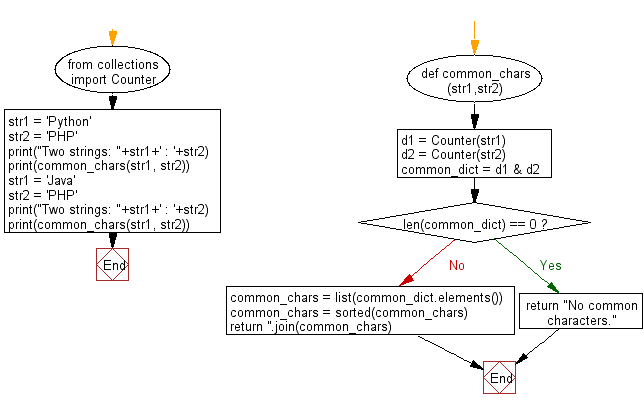Python: Find all the common characters in lexicographical order from two given lower case strings
Common characters between two strings.
Write a Python program to find all the common characters in lexicographical order from two given lower case strings. If there are no similar letters print "No common characters".
Visual Presentation:
Sample Solution:
Python Code:
# Import Counter for counting characters
from collections import Counter
def common_chars(str1,str2):
# Create Counter objects for each string
d1 = Counter(str1)
d2 = Counter(str2)
# Intersection of the counters gives common elements
common_dict = d1 & d2
# If no common elements, return message
if len(common_dict) == 0:
return "No common characters."
# Get list of common characters
common_chars = list(common_dict.elements())
# Sort common characters
common_chars = sorted(common_chars)
# Join the characters into a string
return ''.join(common_chars)
# Test strings
str1 = 'Python'
str2 = 'PHP'
# Print test strings
print("Two strings: "+str1+' : '+str2)
# Print common characters
print(common_chars(str1, str2))
# Test with different strings
str1 = 'Java'
str2 = 'PHP'
# Print test strings
print("Two strings: "+str1+' : '+str2)
# Print common characters
print(common_chars(str1, str2))
Sample Output:
Two strings: Python : PHP P Two strings: Java : PHP No common characters.
Flowchart:

For more Practice: Solve these Related Problems:
- Write a Python program to find the intersection of characters in two lower case strings and return them in lexicographical order.
- Write a Python program to use set operations to find and print common characters between two strings, or "No common characters" if none exist.
- Write a Python program to iterate over two strings and collect characters present in both, then sort the result alphabetically.
- Write a Python program to implement a function that returns the common characters between two strings, ensuring uniqueness and sorted order.
Go to:
Previous: Write a Python program to find maximum length of consecutive 0’s in a given binary string.
Next: Write a Python program to make two given strings (lower case, may or may not be of the same length) anagrams removing any characters from any of the strings.
Python Code Editor:
What is the difficulty level of this exercise?
Test your Programming skills with w3resource's quiz.
